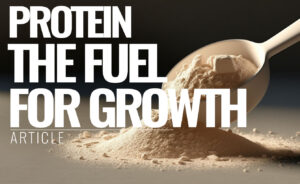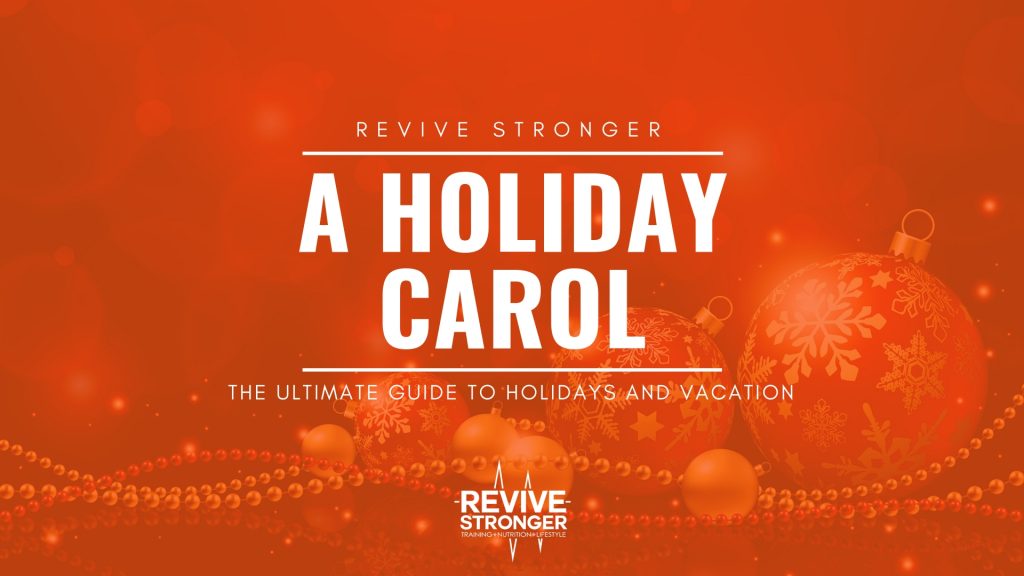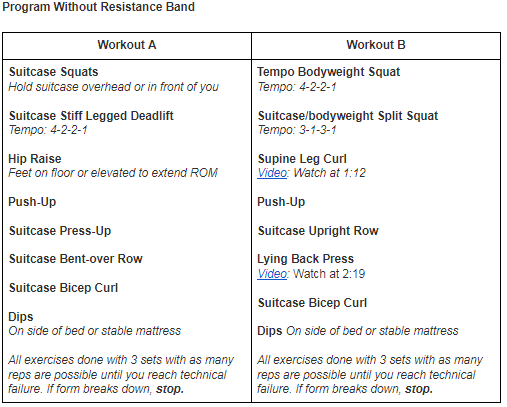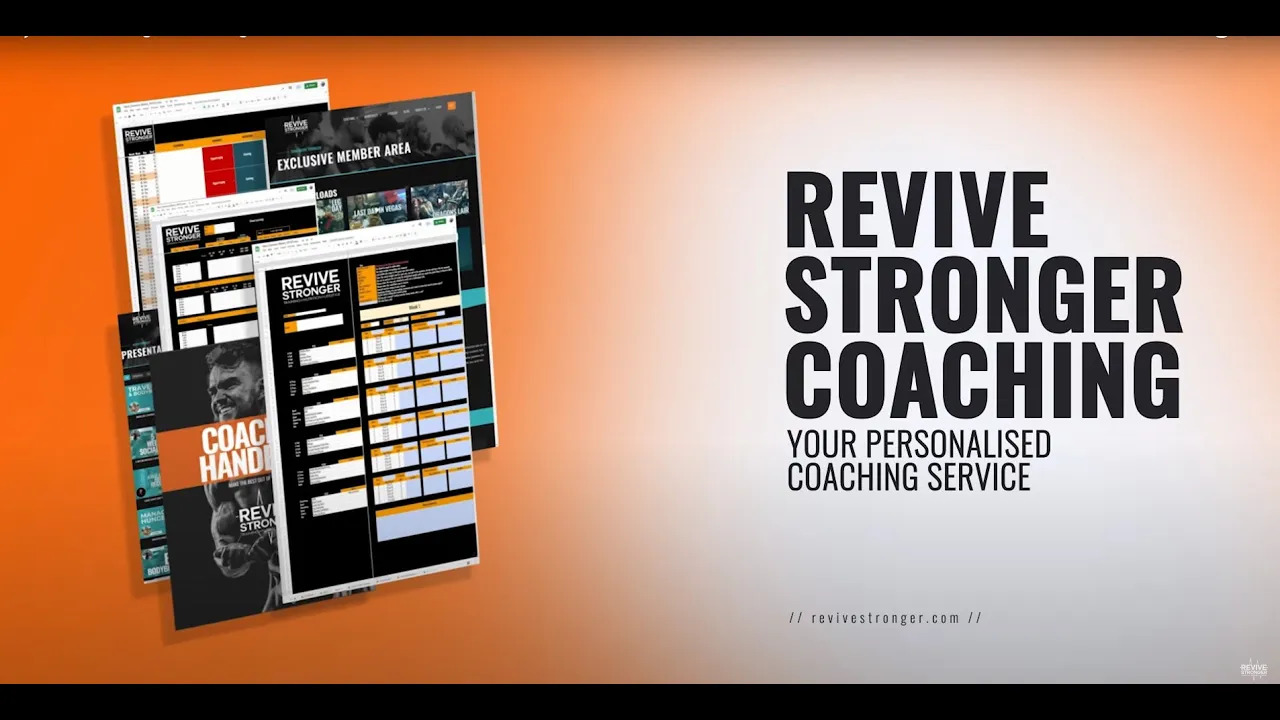
Revive Stronger
A Holiday Carol: The Ultimate Guide to Holidays and Vacation

This article is intended to be different from other quick-read vacation and travel articles. This article is meant to stand out as the most comprehensive, complete and science-based guide for holidays. It includes nutrition and training recommendations for 3 different approaches, 2 science-based hotel programs, and personal stories from myself (Miguel Blacutt), Steve Hall and Pascal Flor.
What a time to be alive! You get to gather with friends, family and go on a trip, or stay home and relax. Funny enough, both will probably involve lots of special food and probably less training than usual. If you’re a very routine-driven person, then this might be a little bit scary. Especially if you really don’t want to gain fat during your holiday and want to stay on top of all your fitness goals. Lucky for you, I will address three different cases during this article.
Those are:
1] You don’t care if you gain fat and don’t work out once. You want to enjoy, you’ve earned this vacation
2] You’re in the middle. You don’t want to gain fat, but you also want to enjoy and are willing to step a little bit outside of your goals.
3] You don’t want to gain any fat, you want to lose fat.
Big Disclaimer: We only recommend this for people who are in contest prep and simply cannot sacrifice any amount of time
Further, this article will also discuss the science behind detraining and muscle loss.
Table of Contents
Nutrition
Before going into the nutrition recommendations for each case, I would like to give evidence-based recommendations on nutrition during the holidays in general. Often, it is propagated that you shouldn’t worry about nutrition during the Holidays whatsoever and that you can’t gain significant weight in such a short period of time. However, a study by Yanovski et al. (2000), found that people gained about 50% of total yearly weight gain in the time period from the third week of November to the first week of January. Essentially, this is the time from Thanksgiving to the end of New-Year festivities – lots of partying, good memories, food and alcohol – enough to significantly contribute to weight gain.
If you accept the weight gain and just want to enjoy yourself…
If you fall into the group of people that just wants to enjoy; I would suggest making the effort to at least maintain a sufficient protein intake and number of protein feedings. I understand that you’re fine with gaining a few extra pounds of turkey, mashed potato and pumpkin pie goodness, but let’s keep your muscles happy while doing so. This will require minimum effort.
Protein Intake: A protein intake of 0.82g/lb will likely be sufficient during this time (Morton et al., 2017). You will most likely be at a caloric surplus, sleep will be high, stress will be low and relaxation will be on point; these factors will minimize catabolic hormones and other factors that lead to protein breakdown. I suggest this intake as a minimum, but if you want to eat more protein than this, that’s fine too!
Frequency: 3-4 meals spread 3-5 hours apart. Muscle Protein Synthesis (MPS) is a process that lasts approximately 3 hours before returning to baseline. Studies by Mamerow et al. (2014) and Murphy et al. (2015) have shown significantly greater MPS when consuming 3 meals with 30g of protein each, compared to a skewed intake where most of the protein was consumed at night. Thus, it is a good idea to maintain a frequent protein intake instead of just relying on your big plate of turkey at the end of the day.
Per meal: At least 20-40g of high-quality protein per feeding. Protein is made up of amino acids; one of the amino acids, leucine, seems to be almost solely responsible for stimulating MPS by acting on a molecule called mTOR. You likely need at least 20g of a high-quality protein source to maximally stimulate MPS, while higher intakes may lead to the response lasting longer.
How: Let’s keep it simple. Protein is filling and your stomach is probably being capped off with vacation goodies; whether it’s gingerbread cookies at home, mojitos by the beach, or fondue after skiing. It will be easier for you to maintain a sufficient protein intake by consuming quick sources that require no cooking.
Easy protein sources that require no cooking
- Protein powder (whey, beef, rice, pea, just make sure it has around 2-3g leucine per serving)
- Greek yoghurt
- Cottage cheese
- Protein bars
- Kwark
- Canned tuna
- Smoked salmon
|
Miguel’s Favorites |
Steve’s Favorites Protein: Denovo – Candy Bar Bar: PhD Diet Whey Bar – Salted Caramel Quest for travel, given they can be crushed, heated and beat up and still taste good Vegan Bar: Clif Builder Bar – Peanut Butter |
Pascal’s Favorites |
The protein sources above will make it easy to keep a solid protein intake without having to dedicate much time to the kitchen. If possible, try to have a protein feeding upon waking – this will ensure that you get at least one decent protein feeding before eating other foods that might fill you up. Additionally, try to have a protein feeding with each meal or larger snack that you have throughout the day.
For example: if you’re about to go in on some cookies, have a shake with it. If you’re eating a banana, have it with some cottage cheese. If you’re at a buffet, get plenty of meat on your plate. I am not saying get more meat and less mashed potatoes – I am simply saying, get a decent amount of meat (or tofu, tempeh, faux-meat, etc.).
If you want to enjoy, but minimize fat gain…
Most of us will fall into this section; which makes my job fun because this is the more “complicated” one to write about. It’s easier to be at extremes; either you eat everything or you have to be very strict due to your competition… but moderation is hard. Moderation means that you actually have to listen to satiety signals and be somewhat thoughtful about what you decide to eat or not. Nevertheless, we can still use some science-based tools in order to minimize fat gain while maximizing your enjoyment with minimal decision-making time.
To do this I would like to consider a few things: having a plan, managing sensory-specific satiety, and managing alcohol intake.
Prepare yourself
Many fear the Holiday weight gain and have a mental plan to avoid it – and it actually works. Two studies by Martins et al. (2004) investigated “Holiday-specific food cues” and their effect on calorie intake. One study gave students a bag of 50 M&M candies before class, which they had to return at the end so their consumption could be tracked. The study was done on Halloween, on this day students were told “Happy Halloween” before candy was distributed. The protocol was repeated on a non-Halloween day, where students were not told “Happy Halloween”. Students were also given questionnaires that measured dietary history. It was found that people who were actively dieting consumed significantly less candy when reminded of the Holiday.
The second study was done 7 days before Thanksgiving and subjects were asked to read a paragraph. One group read a paragraph that was about Thanksgiving and food, while the other was a historical paragraph about Thanksgiving. Then, participants were asked to describe their nutrition plan in terms of their plans to take action against over-indulgence and use the opportunity to strengthen their commitment to avoid overindulgence (on a scale from 1-7).
It was found that when people read the food-paragraph, they were significantly more committed to avoiding overeating on Thanksgiving.
The following research shows that going into your vacation, gathering, holiday, or festivity with a plan to not-overindulge can effectively “raise your defences” against overeating. As a result, you will likely end up eating less.
Sensory-Specific Satiety
Have you ever noticed how the first few bits, especially the first, are always the best? As you eat more of that food, the pleasantness typically diminishes – this is called Sensory Specific Satiety (SSS). Research on SSS shows that the hedonic effect of a food is highest in the early stages of the sensory process and this decreases as the food is consumed (Hetherington, 1995).
A study by Hetherington (1995) gave 57 volunteers a lunch meal after having recorded their levels of hunger, fullness, desire to eat and the pleasantness of cheese on crackers and chocolate. Then they were allowed to eat as much cheese on crackers as they wanted and were asked why they decided to stop eating. After 60 minutes, they were allowed to eat again and could pick between cheese on crackers, chocolate or no second course. The researchers found that the most common reason to stop eating was: “I got tired of eating that food”. It was also found that of the people who decided to have a second course, 78% decided to have chocolate. This study shows that satiety can be specific to a certain food, but more food can be eaten when switching to a food with a different flavour, texture, appearance, flavour and aroma.
In another study by Rolls et al. (1981), subjects were fed a lunch meal that consisted of sandwiches given in 4 rounds. In one test, the subjects were given the same sandwich in all 4 rounds and in the other test, subjects received a different sandwich in each round. It was found that when different sandwiches were given, subjects consumed significantly more in each round and in total.
Image 1. Greater sandwich intake when different sandwiches given at each around (Rolls et al., 1981).
Typically, you eat buffet or family-dinner style during holidays and vacations; meaning you have unlimited access to a wide variety of foods and can eat as much you want (given no one else wants the last popcorn shrimp). Additionally, you will have foods with a wide range of flavours, appearances, aromas and textures all within the same plate. In one Christmas plate, you might have the chewy and savoury turkey, the grainy and soft mashed potatoes, the soft and sweet Cranberry jelly and the slightly dry Pinot Noir. You can see why it is so easy to overeat, as you’re throwing such a myriad of flavours and confusing your poor Sensory Specific Satiety. When you’re eating your main savoury plate, such as I described above, be mindful of the difference between true hunger and simply being continuously stimulated by new flavours.
More importantly, make a conscious effort to actually save space for dessert. Often, you will eat your heart out during the savoury portion of the meal and feel completely stuffed. However, when dessert is brought out, you find that you’re hungry once again. This is not true hunger, it is simply the appearance of a completely new food and new sensory stimulation. You could have already eaten way over your caloric means but will feel appetite return when you get the first bite of those chewy brownies. Thus, a good tip is to stop eating the main-course food when you are moderately full, not stuffed or even completely full. That way, when dessert is brought out, you actually have some space for it.
Additionally, when you make the change from savoury to dessert, make sure not to go back to the savoury! Once you’re done with your turkey, mash and gravy and move onto the pumpkin pie, do not go back for more turkey… and then possibly more pie. Again, this will “confuse” your sensory-specific satiety and give you the illusion that you’re still hungry.
Eat What You Enjoy
Focus on the foods that you truly love… this has been repeated time and time again, but for good reason, it is damn good advice. Often, you arrive at the dinner buffet and feel like you need to serve yourself a large amount of everything. Especially if you’re at a home-made gathering where all the food is prepared with care and the hosts/cooks are making sure you eat what they prepared. Don’t be rude, but don’t feel like you need to eat more than one crab cake if your favourite appetizer is popcorn shrimp.
If you’re in a close gathering where the cooks are paying attention, serve yourself enough to not insult their cooking. However, if you’re in a large gathering where no one is paying attention to what you’re eating or in a hotel buffet where no one will take offence, only go for your absolute favourites!
Alcohol
Briefly, alcohol does contain calories and they can add up quickly, especially in mixed drinks. Alcohol contains 7kcal per gram and can contribute to fat gain when consumed in excess, just like any other calories. Tropical drinks such as Margaritas, Mojitos, Pina Coladas and others are filled with added sugar plus the calories from alcohol. Further, creamy drinks like eggnog, White Russians, Mudslides, Brandy Alexanders and others can have very high-fat milk or cream plus sugar and alcohol. A single drink can have between 150-400kcal, or more, depending on the sugar, cream, fat and alcohol that it contains. Thus, a good strategy is to stick with sugar-free and low-fat mixed drinks and non-mixed drinks (wine, beer, hard liquors, etc).
The problem with alcohol isn’t just with the hundreds, or thousands of calories, that it can add to your intake. It also doesn’t seem to reduce food intake in response to the calories consumed from alcohol. This effectively means that you can drink hundreds (or thousands) of calories from alcohol and still eat an incredibly large meal without your body telling you that you already had those calories (Yeomans et al., 2003). Additionally, it can actually increase your food intake and the pleasantness of food. A third problem is that alcohol suppresses inhibitions, including food restraint. Perhaps you typically allow yourself to have a plate of dessert, but never two because you want to watch your intake. Well after a few drinks, that self-restraint may be lowered and you might find yourself saying yes to the second or third piece of the pie.
When it comes to alcohol, there are a few tips that I would like to leave you with:
– Unless you absolutely love the drink and would not enjoy the occasion as much without it, try to stick with lower calorie non-mixed drinks.
– Keep track of the calories consumed from alcohol, since you won’t feel the “fullness” that you should from those calories
– Remember your normal restrains and the food-habits that you typically implement. You may find yourself very tempted to ignore them.
Protein Intake
Maintain adequate protein intake as specified in the protein section of the “If you accept the weight gain and just want to enjoy yourself…” section of the article.
If you want to lose fat during this time… [ONLY FOR CONTEST PREP]
I will say it again: we only recommend this approach if you are in contest prep and do not have any time to spare. The reason that I state this so many times is because you have the vast majority of the year to lose fat – but only these few weeks to spend with your friends, family and loved ones. To be a little dark, you never know how much longer you have with these people. Whether you want to admit it or not, breaking bread and sharing food is a big part of the experience – it simply is not the same for you to bring your own food or a scale. If you can, resort to one of the two methods discussed above.
That being said, if you’re getting ready for a bodybuilding competition and are tight on time, then you may not be able to partake in the food portion of the festivities. This section will involve a lot less science, but very valuable information gained from experience.
Communication Is Everything: Communicate. Communicate. Communicate. In a very sincere, calm and peaceful manner, tell your friends, family and loved ones about your competitive goals. Explain what you are attempting to do, why it’s so important to you, how much effort you have put into this and why it means that you cannot eat their food, or why you have to weight it.
Do not give off a cocky, or arrogant attitude when saying this. Do not make them feel like you’re above them for choosing to stick to your diet while they feast. Chances are that you will be eating with people who have tried dieting multiple times and have failed; when you show relentless dedication, they may feel bad and throw snide comments or “fat-shame”. Even if you’re eating with the fittest in the world – do not give an arrogant attitude. No one likes to be shamed for what they’re eating. Especially during a special occasion.
Enjoy Everything Else: When you’re dieting for a show, food focus will increase. It may seem that food is the only good part of an event and without it, there is no joy. This is where you are wrong. Food is a large part of gatherings and vacations, but it’s not everything. If you’re having a Holiday gathering like Thanksgiving or Christmas Dinner, then you will probably have good conversations, jokes, stories, music, games, movies, among others. Enjoy those things and appreciate them while you have them!
Do Not Isolate Yourself: It’s easy to be extreme, it’s easy to decide that you’re just not going to leave your house. It’s hard to go out, have a conversation with your peers and stick to your diet. However, you should not allow bodybuilding to prevent you from being with the people that you care about. Your loved ones will appreciate your presence, even if you can’t enjoy the food. For example, Steve managed to go on a trip and a wedding with his girlfriend, Charlote, during his 2017 contest prep.
If You End Up “Cheating”: In the event that you end up caving in and going over your calories, your first instinct might be to be “regretful” or “mad’ at yourself. Perhaps anxious, as show date is approaching and you may have set yourself back. It is understandable that you have these feelings, but do not ruin the experience for your loved ones.
If you start to talk about how much fat the gravy had, how much sugar was in the pie and how oily the meat was, you will probably just make the cooks feel bad about their food and your loved ones feel bad about eating it. No one likes to be told how “fattening” their cooking is and how many calories was in the food they just ate.
Nutrition Considerations: Since you’re in prep, I don’t have to give you tips on what to eat. You know what your macro/calorie targets are and know that to stay on 100% on plan, you have to adhere to them.
One Day Occasions: On occasions such as Christmas, Thanksgiving, birthdays, anniversaries and such, then one thing that you can do in order to make this occasion more enjoyable is to “borrow” food from other days. If you eat somewhere between 10-20% fewer calories on the day before and/or the day after your event you will have more calories to “enjoy” on that day.
Let’s say you are dieting on 2,000kcal per day and have a family gathering on Friday – well then you can eat 1,800 on Thursday and Saturday in order to be able to eat 2,400kcal on Friday. If you combine that with a bit of fasting, you’re looking at a pretty good-sized meal!
Multiple Day Events: In the case of multiple day events, you will have have one of two options and they will depend on how much time you have to plan.
1] You can diet more aggressively than previously planned in order to be able to raise calories slightly during your trip. You will only be able to do this if you’re on track to lose the fat that you need by show date AND you had plenty of time to plan for this. I big caveat to this method is to only do this if you know that restricting food on the day before and/or after will not cause you to feel deprived and overeat or have a full-blown binge.
2] If you do not have time to spare – then you have no choice. You need stick to the macros, even if it means enjoying the trip less. This is one of the major reasons that we encourage starting your prep and being proactive in regards to planning – it allows you to have the flexibility to go with Option 1.
Training
Similar to the nutrition chapter, we will divide this section into three cases. However, before doing so, I will show you the research that we have on de-training. This way, you will know what will happen if you don’t even step into the gym for a few weeks… it’s not as bad as you might think!
In a study by Ogasawra et al. (2013) the researchers recruited 14 untrained men and split them into two groups
- One group trained for 24 weeks continuously
- The other structured training as such: 6 weeks on, 3 weeks off, 6 weeks on, 3 weeks off, 6 weeks on (also a total of 24 weeks)
They found that at the end the end of the 24 weeks, there was no difference in hypertrophic outcomes. How can this be?
It seems that the continuous group made greater gains when the periodic group was taking their 3 weeks off. However, when the periodic group returned to the gym, they made gains at a faster rate than the continuous group. Ultimately, it seems this allows the periodic group to “catch” up to the continuous group and make similar gains.
If you’re reading this, then you’re likely an intermediate or advanced athlete. An advanced training status makes you even more persistent to muscle loss. Muscle fibres have “command centres” called myonuclei that can regulate growth. It seems that as you develop more muscle, you need satellite cells to donate myonuclei to fibres to allow further growth and this process seems to be permanent.
A study by Kadi et al. (2004) found that fibre area did decrease after 90 days of de-training. However, myonuclei number per fibre did not decrease. This suggests that even during long periods of detraining of 3 months, the muscle will be easier to regain.
Hwang et al. (2017) conducted a study in resistance trained athletes where they underwent a 14-day detraining period. The researchers measured lean body mass (LBM), rectus-femoris muscle cross-sectional area and leg-press strength before and after the detraining period. They found no differences in LBM, muscle cross-sectional area or strength following the 14-days of detraining.
The reason I am giving you this evidence before going into the three cases is to show you that it’s not that serious! You are not going to atrophy and lose all your “gainz” because you did not go to the gym for a few days. If people were ‘mirin before the Holidays, people will still be ‘mirin after.
Now to get more serious, let’s break things down into our three scenarios.
1] If you just want to enjoy and not even think of training…
Well, then enjoy! When it comes to nutrition, there is a baseline you can do because at the end of the day… you still need to eat to survive, so you might as well eat some tasty protein. However, there is no minimum amount of training that you must do in order to survive. If you don’t want to train… don’t!
2] If you want to enjoy, but still stay on track…
It is important to note that you need a lot less volume to keep your gains than to make gains. In one of my favourite studies, Bicket et al. (2011) trained both younger (20-35yrs) and older (60-75yrs) subjects for 16 weeks. The subjects performed squats, leg press and knee extensions 3 days per week, with 3 sets of 8-12 per exercise. The subjects gained a significant amount of muscle and strength compared to baseline.
After 16 weeks, the subjects were placed in a second phase that lasted 32 weeks. The second phase consisted of either a
- De-training group (no more training)
- ⅓ of the original volume (only one day per week)
- 1/9 of the original volume (only one set per day)
After the 8-month-long Phase II, it was found that the group that did ⅓ of original volume maintained muscle. The detraining group lost all gains, which makes sense as they spent 8 months without any training after only training for 4 months. The group that did 1/9th of the volume lost muscle but it remained elevated above baseline. Thus, it is much easier to maintain muscle than it is to gain muscle. In this study, it was shown that just ⅓ of the training volume was sufficient to maintain muscle mass for 8 months.
From practical experience, I have found this to be an effective dosage at maintaining muscle mass, given that sets are taken sufficiently close to failure (0-3 reps). Thus, if you want to effectively preserve muscle while spending the least amount of time in the gym and away from the festivities/resort then you can cut volume to around ⅓ of your usual volume per muscle group.
For example, if you typically train each muscle group with 20 sets per week then you will likely be able to maintain that muscle with 6-7 sets per week. I recommend that you split this into whatever way you find disrupts your holiday the least. You could do two full-body sessions and take a little bit longer per session, or do 4 very quick upper-lower sessions, or any other combination you want. Personally, I’m a very early raiser and usually get a quick workout before anyone can even think of starting daily activities.
If you do not have access to a gym, then don’t worry, I still have you covered! In the bottom of this section, you will find that I have created two training protocols – one that involves a resistance band and one that does not. If possible, I suggest bringing a high-quality resistance band, as this will greatly expand the range of exercise that you are able to do.
3] If you’re in contest prep…
When you’re eating in an isocaloric or hypercaloric diet, muscle mass is maintained much easier since catabolic signalling is not as prevalent. During prep, things change due to the nature of the hypocaloric diet. In a fat-loss phase, your body is not getting sufficient energy from external sources so it must oxidize tissue to use as energy. The goal of a diet should be ensure that you oxidize the most amount of adipose tissue with the least amount of muscle. In other words, you want the energy to come at the expense of fat, not muscle. In order to balance things in your favour, you need potent stimuli to tell your body that we need to hold on to that precious tissue, not oxidize it for energy. This will involve well-thought out resistance training with adequate volumes and intensities.
Since you’re in prep, I will trust that you have a program figured out – I will not write out a “General Contest Prep Program For All” as those do not exist. However, I wanted to ensure that you don’t stop training for a few weeks in the middle of a prep thinking that you will be able to maintain all muscle.
Don’t worry, I will leave you with some training tips. If you have access to a gym, whether you’re at home or away, try to stick to your program as closely as possible. If you can’t do a specific movement, try to replace it with a similar movement. Another huge benefit to doing things with plenty of time in advance is to be able to plan where you stay – you can ensure that you have a good gym at the hotel, or at least nearby. If you leave things until the last minute, you might find yourself in a hotel gym equipped with a treadmill and 2 pink dumbbells (we’ve all been there).
If you do not have any access to a gym whatsoever, you may follow the hotel-room workouts that I have written below.
Hotel Room Programs
The following workout will provide you with approximately 6-9 sets per muscle per week – depending on how we’re counting volume. If you have nothing but your hotel room and a suitcase, you can complete the workouts shown below and probably maintain muscle mass. I highly recommend purchasing a good resistance band, with handles on the ends such as this one.
Tempo: Eccentric – eccentric hold – concentric – concentric hold
RB = Resistance Band
This program lacks vertical pulling for a reason – I don’t want you attempting to do a pull-up on a door, breaking the frame and hurting yourself. It sounds funny but I have seen it done. If you have access to a park and can do some pull-ups on a safe bar, great! But if not, do not try to make a DIY Pull-Up-Bar in your hotel room.
You can repeat this program as you have time or according to volume requirements. However, please remember that you are on vacation and should probably not spend hours locked in your room chipping away at your suitcase and resistance band.
Story Time – We’ve Been There!
Throughout this article, you have probably gotten the sense that I don’t encourage you to be a hermit and hide from events or to be overly restrictive. As I have shown you with the studies and their interpretations discussed above, you are not going to lose significant muscle within a few days or even weeks and won’t ruin your body composition (unless this turns into an all-day-every-day food-a-thon).
All three of us at Revive Stronger have been those overly-serious bodybuilders, refusing to stray from our diet and training while feeling a masochistic sense of pride. We hope that sharing our experiences and mistakes with you can help you to understand the behaviours that are completely unnecessary… or even dangerous, as you will read.
Miguel’s Story: Practice Safe Training, Kids
During the freshman year of my bachelor’s, my life was all about bodybuilding and school. This time was the peak of my dedication and intensity towards bodybuilding. While my colleagues slammed beers and ate pizza, I slammed weights and ate “clean”. After the school year was done, my family planned an incredible Safari trip to Tanzania where we stayed in a different exotic hotel each night. Naturally, my first concern at each hotel was whether they had a gym with a weight room and was disappointed at each one, as the answer was always, “No, sorry.”
After a week of not touching a weight, we arrived at a hotel where I was told there was a gym, but it was only for the staff. I insisted that I wanted to go and was told that I would need to be escorted there if I really wanted to and I agreed. I didn’t think much of the escort-requirement, as we had been escorted by men with hunting rifles everywhere due to the risk of being attacked by a wild animal.
A car awaited for me to go to the gym; I got in expecting a 2-3 minute car ride to the gym but was surprised with a 10-15 minute ride into a heavily forested area. I got out of the car to find out the gym was a cement building, about the size of a medium bedroom, in a tiny village, far from the hotel… but it didn’t matter, I was going to get to train!
I entered the “gym” dressed in my expensive lululemon sweatpants and a tight-fitting Under Armour shirt while listening to metal on the latest iPhone. I looked around the poorly lit room and found that the equipment was various construction metal poles with buckets of cement of different sizes attached at the ends. The different size of buckets allowed each bar to have different weights that could be selected. The seats were just regular armless chairs that one could sit at do seated shoulder press, bicep curls, etc. Funny enough, even this gym had a squat rack, but of course, it was self-made.
The door closed behind me and I found myself in this dungeon-like room with 4 strange men, looking at me strangely. At this point, I realized that I was in the middle of nowhere in Tanzania, in a room where anything could be done to me and no one would be able to find me. Anxiety took over for a few seconds, but I knew that I had to act cool. If they were going to do something, then freaking out would only make it worse. If they were good people then they would just enjoy having someone who had studied exercise science and nutrition in-depth training with them – so I started training.
At first, they just stared at me with puzzled expressions. Then one of them asked me what I was doing and why, as I explained, all 4 men stopped everything to listen to my scientific approach. You could have heard a pin drop. After, they copied my every exercise, my every movement. Once I was done with my workout, they wanted to show me their favourite exercises and it turned into a full-bro arm workout with everyone yelling words of encouragement to get that last rep. It was one of the most special workouts of my life and I returned to my hotel safely. However, it could have easily turned out extremely bad. Again, I put myself in a completely vulnerable situation due to my obsession with training – as if one workout could have changed any post-trip outcome.
Now, I just accept the fact that I will go 1-2 weeks without training during the year and have seen absolutely no stalls in progress or muscle loss.
Pascal’s Story: New York, Neeew Yooork
Well, I guess, everything that will come after Miguel’s half raped gangbang, stabbed to death and left to bleed story (now it’s up to you to decide whether he was stabbed to death with a knife or a…) will be like the bondage scenes in 50 Shades of Grey…boring as fuck.
So yeah, it’s March 2015. I’m on my way to New York. It’s my first trip ever to the US and thank god I’ve chosen the time in which there’s an extreme blizzard around that area. I arrived late at night at the JFK-Airport. Tired from the Jetlag, I still needed to drive an hour to my Airbnb apartment in Williamsburg.
Before I got to the apartment though, I immediately learned something quite unpleasant. Never ever travel with a suitcase through a blizzard! The suitcase was too heavy to carry all the way to the apartment but the wheels on it were too tiny to work properly in the snow. Anyway, finally arriving at the apartment, I quickly went to bed because I had everything laid out in front of me with my schedule. Of course, I had some touristy things on my to-do list but what I’m referring to were the Gyms in which I could get a Free-Day-Pass.
Next day I got up and voila…blizzard was still in full roar. You probably expected that I’m going to say that it had subsided by now but hell no, it was awful! If you’ve ever been to New York, you know that the wind is squeezing its way through the tall buildings, fast and hard! I was barely able to raise my head because the snow clasped onto my face like as if a Pokemon spits ice shards at you. You can’t imagine what it feels like? Well, I’d assume it’s painful?!
Anyway, where was I? Ah yeah, gyms!
I heard that New York has a lot to offer when it comes extraordinary food and because during that time, I was still a little dogmatic about how often and much I “needed” to train, I trained every day. So, I decided to train each and every day at a different gym because all of them offered a Free-Day pass and because I was…okay, still am a cheap fuck, I took advantage of their kind offer.
As you may have noticed by now, the gyms were, of course, spread across the entire city. In the end, it was an absolute hassle to fight your way through the blizzard, get to these shitty gyms, train for 1-1.5h and do it all over again the next day.
I’d have been absolutely fine with everything if the training session were somewhat great but they sucked as well! I was still jetlagged, the continuous walking throughout the rest of the day had a big impact on next days sessions and the worst thing about everything was the imperial system.
Constantly I miscalculate the weights I’ve used but I blame the jetlag for it…or no wait, I blame the imperial system for it! The guy that invented the imperial system was a masochistic and cruel man, who wanted to see the world go up in flames. Famine, wars, hatred all over. That’s the type of person who invented that!
Alright, I’m back and calm again. What’s the moral of the story you may ask?
Ever since then, I had holidays in which I took completely time off the gym and guess what, I had a better time and better training after I came back.
Mate, you have the rest of your life to train, a couple of weeks out of the gym won’t do any harm. Especially now with all the research, we have at our disposal in that area too.
Relax and enjoy your holiday!
Steve’s Story: Fuck you family, in Florida
Many years ago I went to Florida with my family, what a treat!
We were doing the whole Florida thing, you know; Disney, Universal, water parks etc. etc. A holiday most kids dream of and well America has some of the tastiest foods on the planet.
However, at this time I had recently learnt about macros, I was using myfitnesspal and let’s just say I was a little kean. By a little kean I mean I had to track everything. This lead to a few things happening:
1] I bought kitchen scales on the first day from Wal-Mart
2] I refused to go to restaurants without their macros online
I look back at this time and I think “ohhhhhh Steve, you twat”, but this was better than what I was like in the past. In the past, I’d not even eat out due to the food not being ‘clean’, so this was actually a step in the right direction…sort of.
The most upsetting thing is that I likely negatively impacted my families experience, forcing them to go to particular restaurants. I also probably took away from my own experience, by excluding certain foods. I mean this diet still wasn’t a good one, before I excluded foods I deemed ‘dirty’ and now I excluded those that didn’t fit or didn’t have macros!
Since then I have got much better with my food, I don’t take and/or buy scales to weigh things. I don’t exclude certain restaurants because they don’t have their macros available. Holiday is when I really dim the switch on my diet, relax, enjoy new foods/cultures and most importantly, don’t detract from other peoples experiences.
Just because Pascal brought up New York, I went there in 2015 with my girlfriend and we ordered a whole pizza pie after a late night. This thing was freaking massive, no way I was thinking hard about macros, each slice was probably the equivalent to a pizza in itself…I ate my half and a slice of Charlotte’s…she only managed one slice…Now, this isn’t me telling you to binge on holiday, we walked thousands of steps every day and hadn’t had dinner, so you can see why I was hungry.
Also, final thing, do I completely switch off on holiday? No, for me I just can’t, I envy those who can. But importantly this doesn’t detract from the experience and as I said, I have learnt and am able to dim my switch.
Conclusion
If you’re ready to enjoy without a worry…
Try to have 3-4 protein feedings with 20-40g of high-quality protein per feeding – this shouldn’t be too hard with turkey leftovers or fajitas by the beach! Have a great time! Structured nutrition and the gym will wait for you when you return.
If you want to enjoy, but with some moderation
Mentally prepare yourself – as silly as it might sound, having a mental plan to not overdo it will likely help you eat less (Martins et al., 2004). Further, be careful with sensory-specific satiety, as this will “trick” you into thinking that you are still hungry, even though you have already consumed enough food (Rolls et al., 1981; Hetherington et al., 1996). Alcohol can also add up to a substantial amount of calories, especially when mixed with sugar, creams or both and you may not sense the satiety from consuming those calories. Additionally, alcohol may lower your inhibitions and have you going for that third plate of food. With all of this in mind, remember to enjoy yourself! Do not overly stress. Eat what you enjoy, practice moderation without over-restriction.
To avoid spending your entire holiday at the gym, you can cut down your volume by ⅓ and maintain muscle mass. If you cannot go to the gym, you can follow one of the programs created for you. If that also is not possible, then don’t sweat it! Keep in mind that it will likely require more than 2 weeks of complete detraining for there to be losses in muscle cross-sectional area. Further, any muscle that is lost will become quickly
If you are in contest prep…
Plan, plan, plan! Communicate, communicate, communicate! The more you can plan ahead, the more flexibility you will be able to work into your holidays and vacation. The better you communicate, the more understanding and cooperation you will get from the people around you.
If you can, attempt to borrow calories from other days in order to be able to enjoy single-day events with more food. In the event of a multiple-day event, you can structure a more aggressive diet leading into the event so that you can take a diet-break or at least diet less aggressively. A caveat to this method is if you feel like being more aggressive on certain days will leave you with a bigger probability to “cheat” on your diet.
Further, try to plan your vacation well in advance so you can have access to a good gym. Unlike an iso- or hyper-caloric diet, your energy deficit can lead to catabolism in the absence of anabolic stimuli. It will be much more important for you to train than those in the other two groups. If you have access to a gym, train as you usually would. If you do not have access to a gym, you may follow one of the hotel-room workouts provided.
For all…
Whether you can enjoy all the food or not, enjoy this time. Whether you’re celebrating a religious holiday, long weekend or going on a trip, make the best out of it with whatever situation you’re in. You can still have the time of your life without having to eat thousands of calories.
References
Abou-Samra R, Keersmaekers L, Brienza D, Mukherjee R, Macé K. Effect of different protein sources on satiation and short-term satiety when consumed as a starter. Nutr J. 2011;10:139. Published 2011 Dec 23. doi:10.1186/1475-2891-10-139
Bickel, C., Cross, J., & Bamman, M. (2011). Exercise dosing to retain resistance training adaptations in young and older adults. Medicine and Science in Sports and Exercise, 43(7), 1177-87. doi:10.1249/MSS.0b013e318207c15d
Hetherington, M. (1996). Sensory-specific satiety and its importance in meal termination. Neuroscience and Biobehavioral Reviews, 20(1), 113-117. doi:10.1016/0149-7634(95)00048-J
Hwang, P., Andre, T., McKinley-Barnard, S., Morales Marroquín, F., Gann, J., Song, J., & Willoughby, D. (2017). Resistance training–induced elevations in muscular strength in trained men are maintained after 2 weeks of detraining and not differentially affected by whey protein supplementation. Journal of Strength and Conditioning Research, 31(4), 869-881. doi:10.1519/JSC.0000000000001807
Kadi, F., Schjerling, P., Andersen, L., Charifi, N., Madsen, J., Christensen, L., & Andersen, J. (2004). The effects of heavy resistance training and detraining on satellite cells in human skeletal muscles. The Journal of Physiology, 558, 1005-12.
Mamerow, M. M., Mettler, J. A., English, K. L., Casperson, S. L., Arentson-Lantz, E., Sheffield-Moore, M., Layman, D. K., … Paddon-Jones, D. (2014). Dietary protein distribution positively influences 24-h muscle protein synthesis in healthy adults. The Journal of nutrition, 144(6), 876-80.
Martins, C., & Vallen, B. (2014). The impact of holiday eating cues on self-regulatory bolstering for dieters and non-dieters. Psychology & Health, 29(9), 999-1013. doi:10.1080/08870446.2014.900682
Morton, R., Murphy, K., McKellar, S., Schoenfeld, B., Henselmans, M., Helms, E., . . . Phillips, S. (2017). A systematic review, meta-analysis and meta-regression of the effect of protein supplementation on resistance training-induced gains in muscle mass and strength in healthy adults. British Journal of Sports Medicine, Bjsports-2017-097608, 2017-097608
Murphy, C. H., Churchward-Venne, T. A., Mitchell, C. J., Kolar, N. M., Kassis, A., Karagounis, L. G., Burke, L. M., Hawley, J. A., … Phillips, S. M. (2015). Hypoenergetic diet-induced reductions in myofibrillar protein synthesis are restored with resistance training and balanced daily protein ingestion in older men. American journal of physiology. Endocrinology and metabolism, 308(9), E734-43.
Ogasawara, R., Yasuda, T., Ishii, N., & Abe, T. (2013). Comparison of muscle hypertrophy following 6-month of continuous and periodic strength training. European Journal of Applied Physiology, 113(4), 975-85. doi:10.1007/s00421-012-2511-9
Rolls, B., Rowe, E., Rolls, E., Kingston, B., Megson, A., & Gunary, R. (1981). Variety in a meal enhances food intake in man. Physiology & Behavior, 26(2), 215-221. doi:10.1016/0031-9384(81)90014-7
Yanovski, J. A., Yanovski, S. Z., Sovik, K. N., Nguyen, T. T., O’Neil, P. M., & Sebring, N. G. (2000). A prospective study of holiday weight gain. The New England journal of medicine, 342(12), 861-7
Yeomans, M., Caton, S., & Hetherington, M. (2003). Alcohol and food intake. Current Opinion in Clinical Nutrition and Metabolic Care, 6(6), 639-44.
.
We are a personal coaching service that helps you achieve your goals. We want you to become the best version of yourself.







